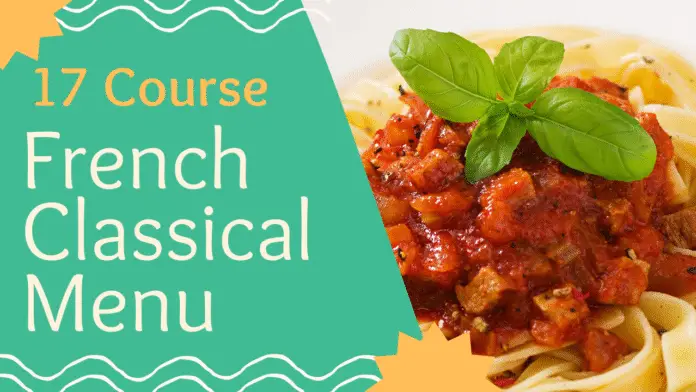French Classical 17 Course Menu Explained Simply
- Hors-d’oeuvre (Appetizer)
- Potage (Soup)
- Oeuf (Egg)
- Farineaux (Rice/Pasta)
- Poisson (Fish)
- Entrée (First Meat Course)
- Sorbet (Palate Cleanser)
- Relevé (Main Meat Course)
- Rôti (Roast)
- Légumes (Vegetables)
- Salades (Salad)
- Buffet Froid (Cold Buffet)
- Entremets (Hot/Cold Dessert)
- Savoureux (Savoury)
- Fromage (Cheese)
- Dessert (Fruits & Nuts)
- Boissons (Beverages)
A French classical menu, as the name suggests, is a classical menu coming from the old French times. It was the finest and perfectly crafted menu which consisted of a series of small dishes.
Although it is not used in recent times, it is still one of the most overwhelming and once-in-a-lifetime experiences for all food lovers across the globe. For budding and aspiring chefs, it is one of the must-learn and must-know things. Because of being a very large setup, the modern guest doesn’t have that much time to dine and experience this big menu. Also, the current health-conscious generation does not allow themselves to overeat.
There are 17 courses in the French classical menu:
1. Hors-d’œuvre (Appetizer)
It is also known as an appetizer. It is generally spicy, tangy, and served in a very small amount. It is made in small portions. Examples include smoked salmon or chilled melon.
2. Potage (Soup)
Soup is one of the great appetizers after the first meal. There are generally two types of soup served – clear or thick. Soup is generally a liquid dish which is served as a drink and usually taken with a soup spoon.
3. Oeuf (Egg Course)
In the modern era, it is also known as “Oeuf”. There are many styles of cooking eggs. A few examples are omelette, boiled, scrambled, and sunny side up. Generally, it is served with bacon and eaten using a fork and knife.
4. Farineaux (Pasta/Rice)
It is an Italian-origin dish that has come into the French menu. There are different types of pasta like spaghetti and lasagna. There are more than 200 varieties of pasta. The ingredients and taste can be creamy, tangy, etc. For a modern person, this is already enough, and it is very hard to have more beyond this. At least it isn’t possible for me to go beyond this if I ever try it in my life.
5. Poisson (Fish)
Also known as fish in French. It is one of the most complicated dishes, as salmon and different varieties of fish can be used. It is a very tender and soft meat and a great start for the heavier dishes that follow. It can be prepared in two ways – either poached or grilled/baked. If it is poached, it is generally served with sauces such as Hollandaise or mayonnaise. If it is grilled, it is served with its appropriate accompanying sauce separately.
6. Entrée (First Meat Course)
This is the first meat course in the menu. It is a very small dish but very well garnished. It usually comes with gravy. Some examples include sautéed chicken.
7. Sorbet (Palate Cleanser)
This is a refreshing iced dish served between the heavier meat courses to cleanse the palate and help the digestion. It refreshes the taste buds.
Examples include lemon sorbet, orange granita, or champagne punch.
8. Relevé (Main Meat Course)
This is the main meat course in the menu. It is larger than the previous one. Potatoes and green vegetables are generally served along with this dish. For many people from this generation, this would already be too much. But the previous generations had more appetite and wanted to eat more. So let’s continue with the rest of the menu.
9. Rôti (Roast)
This includes chicken, turkey, or duck, served with its own sauce. It again comes with green vegetables and potatoes on the side. It is a gravy-based meat dish.
10. Légumes (Vegetables)
Now we reach the vegetable course. It generally includes baked potatoes, grilled mushrooms, or sautéed vegetables, served with sauces. A purely vegetarian course in the menu.
11. Salades (Salad)
There are many ways to prepare salads. It is eaten after the heavy dishes to refresh the body and digestion.
12. Buffet Froid (Cold Buffet)
This includes small pieces of chilled meats like lobster mayonnaise. It is a bite-sized, light, and refreshing dish.
13. Entremets (Hot or Cold Dessert)
This includes sweet dishes like cakes, pastries, cookies, and more. These are usually the desserts served before fruits.
14. Savoureux (Savoury)
This is generally salty, small-sized food served to remove the sweet taste left in the mouth by the desserts or cheese. It helps balance the palate.
15. Fromage (Cheese)
This course includes cheese served with crackers, butter, or celery.
Examples include Cheddar, Gouda, Brie, or Blue Cheese.
16. Dessert (Fruits & Nuts)
This is the fresh fruit course usually served at the end of the meal. It includes fruit platters, cut watermelon, pineapple, apples, or oranges. Dry fruits can also be included depending on availability.
17. Boissons (Beverages)
This is the final course of the French 17-course menu. You get options to drink either hot or cold beverages like coffee, tea, hot chocolate, or herbal teas depending on guest preference.
For me or any normal person, this is more than enough to feel heavy for the day. But still, it is one of the most luxurious and elegant experiences in the world of food.


